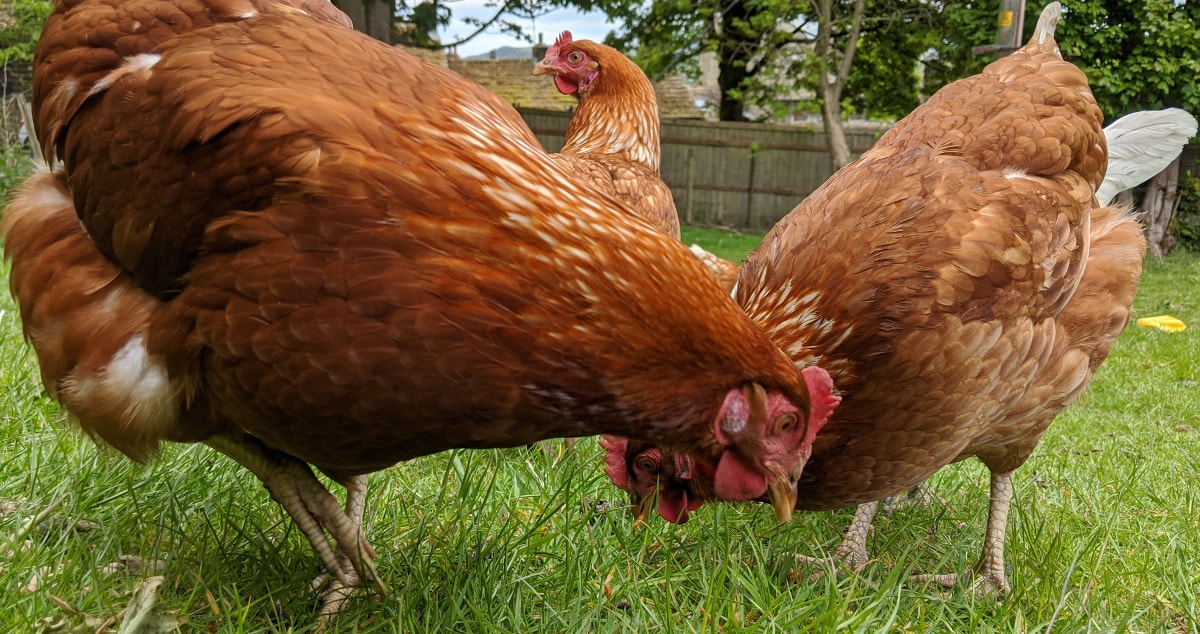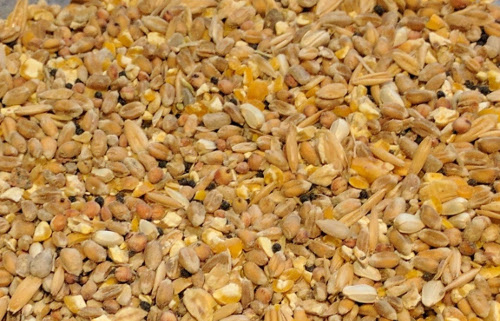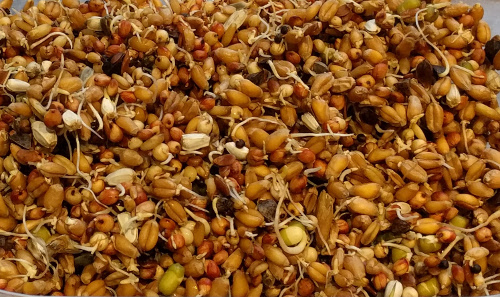Chicken scratch grains, when and how much.

One type of feed for poultry is known as chicken scratch.
You’ve probably already heard the term, as it is a popular treat used by many chicken owners. However, you may be wondering if this is a good option for your chickens.
Table of Contents
- What is Chicken scratch?
- Why is it Called Chicken Scratch?
- What is in Scratch Grains for Chickens?
- Can chickens eat only scratch grains as food?
- Do chickens have to have scratch grains?
- What is the difference between layers feed and scratch grains?
- How do you make home-made chicken scratch?
- Will wild birds steal and eat chicken scratch?
- How nutritious are scratch grains?
- Is Scratch Good for Chickens?
- How Often Do You Feed Chickens Scratch?
- What happens if you overfeed scratch grains?
- From what age can chickens get scratch grains?
- Where is the best place to buy Chicken scratch?
- How and where do you store chickens scratch?
- Final Thoughts
If you want to learn more, this article will tell you everything you need to know about chicken scratch, including what it is, what it’s good for, and how often you should be feeding it.
What is Chicken scratch?
Scratch grains are a mixture of seeds and grains meant as an occasional food for chickens to help improve the variety in their diet and help keep them entertained and busy scratching. Scratching about is how chickens find their food and this mixture encourages that behaviour.
It should never make up more than 20% of the diet of your backyard flock.
Below: This is what scratch grains for chickens looks like.

This is my scratch mixture and it contains wheat, oats, milo, safflower, sunflower without shells, oil seed rape and split maize as well as grit and shell.
Below: You can sprout scratch grains as well, this is what mine look like after a day or two growing.

Why is it Called Chicken Scratch?
Chicken scratch is an odd-sounding name, and it’s often confused with the term one uses to describe messy handwriting. When you’re talking about keeping chickens, however, the term has a different meaning.
Chicken scratch got its name because when the mixture is scattered outside the coop, the chickens will scratch at the ground to find the seeds and grains. This scratching is a type of foraging, which is what birds do in the wild to find food.
Keeping chickens in your backyard is a great experience, but your chickens can quickly become bored if their environment does not include enough enrichment.
Below: Here is a video of some of my egg flock helping themselves.
Providing chicken scratch is one of the many ways you can encourage foraging and enrichment in your chickens.
Birds in the wild often spend hours every day foraging for food. If it is too easy for your chickens to get food, they will probably find that they don’t have a whole lot to do with their time.
After all, it’s not like they can take up hobbies like painting or violin, can they? Chicken scratch is a good supplement that allows your chickens to find interest in their environment.
What is in Scratch Grains for Chickens?
While the name describes how chickens go about feeding on chicken scratch, it does little to tell you what’s actually in the feed. Different brands and varieties of chicken scratch will have different seeds and grains, but they do typically contain the same kinds of ingredients.
Chicken scratch usually consists of a combination of oats, barley, corn, wheat, milo, millet, and sunflower seeds. The percentages of these grains and seeds vary, so you should do some research to find a combination that is right for your chickens.
You can also make your own or add some more interesting things to a bought mix.
Can chickens eat only scratch grains as food?
Scratch is mixed specifically for chickens, so yes, your chickens can eat scratch, just not all the time. They need a balanced and varied diet.
In fact, they love it! Chicken scratch is filled with yummy seeds, so your chickens are likely to spend time foraging around their run for the various seeds and grains found in chicken scratch.
However, as we will discuss later on in this article, there are some stipulations when it comes to feeding chicken scratch.
Do chickens have to have scratch grains?
No they don't have to have it but it does make their life more interesting. I also find it useful to have a few handfuls before roosting time so as I get the opportunity to look my birds over for any issues.
You get to see them moving about and scratching and you can see if any of your flock are not eating properly or have other problems.
What is the difference between layers feed and scratch grains?
Layers feed is a formulated and tested product that is designed and mixed with minerals and additives to make sure your chickens have everything they need to keep them healthy and well fed. Layers feed are formulated to have 16 % or so protein for laying hens and enough calcium in the feed to see the shells stay strong.
Scratch grains on the other hand is a basic mixture of seeds and grains that is often mostly wheat as that is the cheapest component.
Layers contains many other minerals, supplements and the right levels of protein and calcium for laying hens.
How do you make home-made chicken scratch?
If you don’t feel like purchasing chicken scratch, it’s very easy to make it on your own. If you want to make your own chicken scratch, you should combine various dried seeds and grains, including oats, barley, corn, wheat, milo, millet, or sunflower seeds.
Another advantage of making or adjusting your own is you can add some things when the flock need it like a little more calories and protein in the fall when the moult starts or like do add 2% Grit and shell to the mix. Adding cooked and unsalted peanuts to chickens scratch grains is ideal for this purpose.
When you make your own you can add what you want to rather than having being stuck with the 50% wheat blend that most companies sell.
Remember to make up a batch that is an appropriate size to the number of chickens you have. Making up 6 or more 50lb bags is overkill if you only have 6 hens.
Usually, chicken scratch includes three different kinds of seeds or grains, but you can use more if you prefer. Combine equal amounts of each material in a large bin and mix it thoroughly.
Will wild birds steal and eat chicken scratch?
Just like chickens, wild birds love the ingredients in chicken scratch, as well. If you scatter chicken scratch by your coop, however, wild birds are quite likely to feed on it.
If you happen to have any extra chicken scratch, it can make a great addition to any bird feeders. You can also scatter some chicken scratch away from the coop to attract wild birds to your yard. Of course, any sort of seeds or grains will be sure to attract squirrels, as well.
How nutritious are scratch grains?
Chicken scratch is known as the old favourite chicken feed. This type of chicken feed consists of a mixture of whole grains and cracked corn. However, this cannot be their only form of diet because it would be like the equivalence of a human diet of waffles for breakfast, lunch and dinner.
Practically all foods contain varying amounts of starch, oils and fats, proteins, minerals and other nutrients. For Instance, 100 pounds of corn contains 7.5 pounds of protein, 67.8 pounds of starch, and 4.6 pounds of oil and 100 pounds of wheat contains 9.2 pounds of protein, 67.2 pounds of starch, and 1.6 pounds of oil.
This is the Nutritive ratio. 100 pounds of corn contains 7.5 pounds protein and 78.2 pounds carbohydrates. There is 1 pound protein to each 10.4 pounds of carbohydrates, therefore, we say the nutritive ratio is 1 to 10.4.
A ratio this low in protein is no good for the long term feeding of poultry.
Is Scratch Good for Chickens?
This is to some extent breed dependant. Heritage breeds can get by better with grains in the diet where as a more productive modern hybrid really needs much more easily digestible pelleted feed in their diet.
While your chickens will be sure to adore chicken scratch, you’re probably wondering if chicken scratch is any good for them in the first place. Unlike chicken feed, which contains essential nutrients and proteins, chicken scratch isn’t quite as healthy.
It does lend itself well to feeding at certain times, like last thing before roosting so as the birds have a full crop before bedtime.
Chicken scratch does contain plenty of carbohydrates, so if your chickens are underweight, this is a great supplement for weight gain. However, too much chicken scratch will quickly become unhealthy.
Back in the day, chicken scratch was a common staple for feeding chickens. However, over the years, the practice of feeding chickens has constantly evolved as new information and research has changed. Now, there is more research to suggest which kinds of foods are healthier, and we now know that chicken scratch isn’t quite as healthy as it was once thought to be.
Try and think of chicken scratch like a tasty dessert or snack. Your chickens will love it, but that doesn’t mean it’s the healthiest thing in the world. As we will discuss more thoroughly later on in the article, chicken scratch should be fed as only a small percentage of their diet, and it should never be a substitute for actual chicken feed.
It might be easy to get chicken scratch and chicken feed confused. However, chicken feed is completely different. Chicken feed is specifically designed to give your chickens the exact nutrients they need to stay happy and healthy. Chicken scratch is mostly made from carbohydrates, and it provides very little nutritional value. Of course, this doesn’t mean that chicken scratch is inherently bad for your chickens; it simply means that it should be fed in moderation.
Some people choose not to feed their chickens scratch at all, as they believe it has little value. However, if fed before bedtime, some scratch can help your chickens gain weight and stay warm during cold winter months. Furthermore, when you first get your chickens, using chicken scratch can be a valuable tool for gaining their trust.
How Often Do You Feed Chickens Scratch?
You can feed a little scratch every day. I like to give it to my chickens late in the day before they roost to make sure they all have full crops to sleep on.
A chicken that is fed too much chicken scratch will not get the essential nutrients it needs. It will be easy to see if your chickens are malnourished, as they will lose energy, become lethargic, and they will likely have ratty feathers and dull eyes.
If you notice any of these symptoms in your chickens, you should hold back on the chicken scratch right away. Too much chicken scratch is akin to eating junk food. Furthermore, the malnutrition caused by the excessive feeding of chicken scratch can result in poor egg production.
You might find it helpful to increase the amount of chicken scratch you feed during the winter months so that your chickens are well-insulated from the cold. I sometimes boil it in water and feed it warm (40 C) to the hens first thing in the morning to get them going.
A good rule of thumb is that snacks and treats should make up approximately 10% of your chickens’ diet. Assuming you’re feeding your chickens about a half a cup of feed every day, that leaves only a few beak fulls of treats to make up 10% of each chicken’s diet.
While that may seem like a small amount, a little bit goes a long way; chicken scratch is filled with carbohydrates and empty calories. You should be feeding enough scratch that your chickens can consume most of it in about two or three minutes. If you find that it takes longer for your chickens to eat the scratch, you are probably feeding them too much.
Of course, don’t let this discourage you from feeding your chickens chicken scratch altogether! So long as you know to feed it to your chickens in moderation, they will certainly thank you for the occasional tasty treat. There’s nothing wrong with some extra carbs now and again.
What happens if you overfeed scratch grains?
In the short term, probably very little except for an increased chance of some crop issues as chickens that are not used to so many whole grains will struggle to digest them. Over time too much scratch will cause digestive problems and nutrient shortages and after a few weeks it will effect egg production and the overall health of the chicken.
Scratch sometimes contains barley which has a digestive inhibitor in it called lectin which can effect the absorption of other nutrients. Any diet over 4% barley is likely to start causing problems.
From what age can chickens get scratch grains?
I soak the scratch in warm water for a few hours for younger birds, but my chickens get introduced to it in week two.
Just a teaspoon or so of soaked grains popped into the brooder.
Where is the best place to buy Chicken scratch?
Your local animal feeds merchants or county mills.
Online from Amazon or another supplier.
Walmart do a large range of feed and scratch.
How and where do you store chickens scratch?
Store your home-made chicken scratch in a cool and dry area. Make sure it doesn’t get wet, or else the seeds will begin to sprout. Furthermore, moisture can cause mould and mildew to grow, which can be dangerous for your chickens.
Storing poultry feeds is straight forward but you’ll find a few stumbling blocks to watch out for, particularly if you are new to chicken keeping. Buying a 25kg sack of chicken feed and leaving it cut open in a garden shed or outhouse is not really a solution.
Whenever you buy a feed, like a layers, mash or mixed corn through your merchant it will usually arrives in a 20Kg or 25Kg sack. You need a properly ventilated, cool, dry shed or similar place to store it.
To avoid the dry feed getting damp it must not be kept on a cold damp floor or in a humid environment. Dried foods will quickly go mouldy and some fungi are very poisonous to chickens.
Without ventilation you may get moisture build-up or condensation. A wooden pallet is a great idea when you have more than a couple of bags to keep because this permits air to move beneath the sacks.
Rats and mice are a big problem and will consume and contaminate chicken feed very quickly. Mice may be a problem but are generally more easily dealt with. Firstly make sure rats can’t get into the storage area and use a metal bin with a lid to keep them out.use rat traps and examine them often.
When you want to keep 2 or 3 bags, then a wise decision is to utilise galvanised bins. Rats can chew up through wood and plastic but they cannot get by galvanised steel.
Lastly, keep your eyes on the best before date as foodstuffs deteriorate over time. Although the feed appears to look fine, several of the nutrients and vitamins may been useless and chick crumbs or growers pellets which have additional drugs might not be as efficient. If you are keeping your feed more than 3 months it probably means you need to buy less or smaller bags.
Chicken feed is not that cheap and if kept in an unlocked shed away from the dwelling it may be stolen. Horses, sheep and goats and wild animals will also thieve feed wherever they can.
Final Thoughts
People have been keeping chickens for centuries, but a lot of new research has come out in the last few decades alone. While chicken scratch was once a popular staple for feeding chickens, new information has shown that it can be very unhealthy if fed in excessive amounts.
To keep your chickens looking and feeling healthy, as well as to promote egg-laying, chicken scratch should only be fed in small amounts.
On average, this fun treat shouldn’t make up more than 10% of your chickens’ diet; the rest of their caloric intake should come from chicken feed, which has far more essential nutrients. When it is fed correctly and in the right amounts, however, chicken scratch is a great way to help your chickens have fun foraging. In moderation, chicken scratch is a tasty dessert that your chickens will love.
It all comes down to proper chicken feeding. You see, feeding your chicken the proper diet will guarantee that your chicken will grow up to be healthy and full of flavour. Wild chickens on the street will eat just about anything they find and survive for a while but usually will not last that long. And though backyard chickens wont think twice about eating the first thing they find on the ground, it is in your best interest to feed your chicken the correct balance of food and water to ensure a long and healthy flock.
